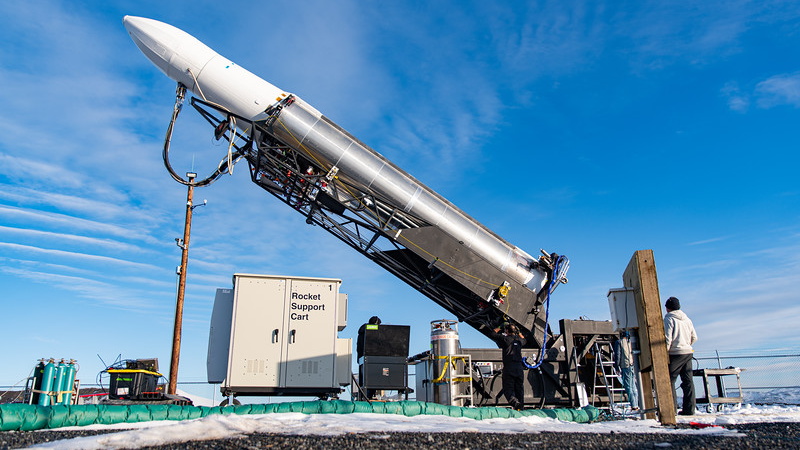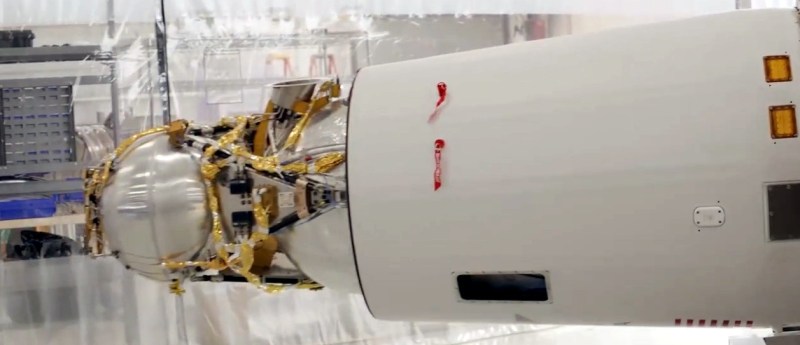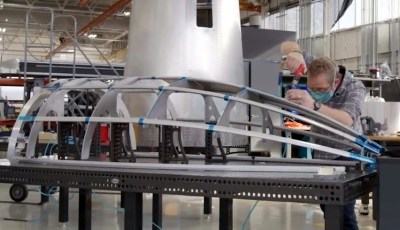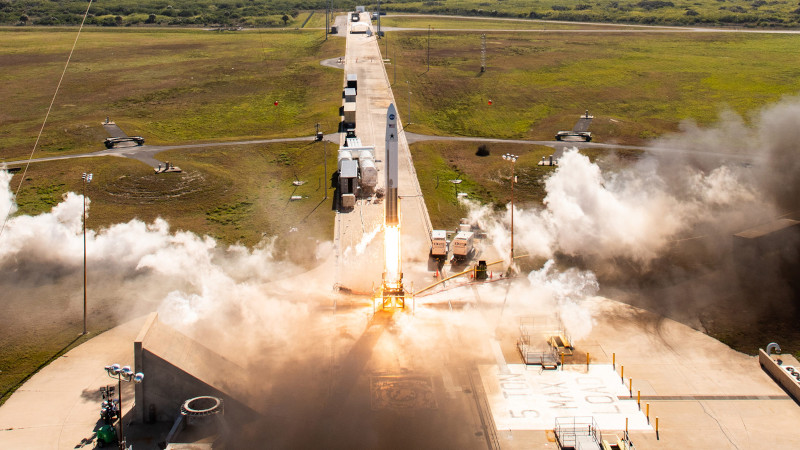We’ve all heard it said, and it bears repeating: getting to space is hard. But it actually gets even harder the smaller your booster is. That’s because the structure, engines, avionics, and useful payload of a rocket only make up a tiny portion of its liftoff mass, while the rest is dedicated to the propellant it must expend to reach orbital velocity. That’s why a Falcon 9 tipping the scales at 549,054 kilograms (1,207,920 pounds) can only loft a payload of 22,800 kg (50,265 lb) — roughly 4% of its takeoff weight.
As you might imagine, there’s a lower limit where there simply isn’t enough mass in the equation for the hardware necessary to build a fully functional rocket. But where is that limit? That’s precisely what aerospace newcomer Astra is trying to find out. Their Rocket 3 is among the smallest orbital boosters to ever fly, closer in size and mass to the German V2 of World War II than the towering vehicles being built by SpaceX or Blue Origin. Even the Rocket Lab Electron, itself an exceptionally svelte rocket, is considerably larger.
 The reason they’re trying to build such a small rocket is of course very simple: smaller means cheaper. Assuming you’ve got a payload light and compact enough to fit on their launcher, Astra says they can put it into orbit for roughly $2.5 million USD; less than half the cost of a dedicated flight aboard Rocket Lab’s Electron, and competitive with SpaceX’s “rideshare” program. Such a low ticket price would have been unfathomable a decade ago, and promises to shake up an already highly competitive commercial launch market. But naturally, Astra has to get the thing flying reliably before we can celebrate this new spaceflight milestone.
The reason they’re trying to build such a small rocket is of course very simple: smaller means cheaper. Assuming you’ve got a payload light and compact enough to fit on their launcher, Astra says they can put it into orbit for roughly $2.5 million USD; less than half the cost of a dedicated flight aboard Rocket Lab’s Electron, and competitive with SpaceX’s “rideshare” program. Such a low ticket price would have been unfathomable a decade ago, and promises to shake up an already highly competitive commercial launch market. But naturally, Astra has to get the thing flying reliably before we can celebrate this new spaceflight milestone.
Their latest mission ended in a total loss of the vehicle and payload when the upper stage tumbled out of control roughly three minutes after an otherwise perfect liftoff from Cape Canaveral Space Force Station in Florida. Such issues aren’t uncommon for a new orbital booster, and few rockets in history have entered regular service without a lost payload or two on the books. But this failure, broadcast live over the Internet, was something quite unusual: because of the unconventional design of Astra’s diminutive rocket, the upper stage appeared to get stuck inside the booster after the payload fairing failed to open fully.
A Slight Second Stage
To understand this failure, we have to take a step back and look at the design of a conventional multi-stage rocket. While an oversimplification, it would be fair to say that the upper stage is generally just a smaller version of the first stage. It will be shorter in length, perhaps more narrow in diameter, and have fewer engines; but fundamentally its design will resemble that of its larger counterpart. The payload is mounted to the top of the upper stage, which in turn is enclosed by an aerodynamic fairing or nosecone.

But Astra’s Rocket 3 is unique in that its second stage looks nothing like the first. Rather than a sleek rocket, its design is more reminiscent of a satellite; with exposed tanks and a skeletal structure that would never survive flight through the dense lower atmosphere. Since this stage will be traveling through the wispy upper atmosphere where drag isn’t a concern, Astra decided to strip it down to the bare essentials to reduce its mass.

The downside of this design is that the fragile upper stage must be covered until the rocket has gained considerable altitude. So rather than placing just the payload into a protective aerodynamic fairing, the entire second stage needs to be enclosed. The lower portion of the second stage is tucked into the hollow interstage, and an elongated fairing makes sure the payload and its ride to space aren’t exposed to supersonic airflow in the early phases of flight.
Costly Compromise
The beauty of this design is that the material used to construct a payload fairing, usually carbon fiber or fiberglass, is exceptionally lightweight. Even taking into account the additional fairing length required, the overall weight ends up being lower than if the second stage had a more traditional rigid fuselage. That said, there’s a glaring problem with this approach if you’re looking to build the cheapest rocket possible: producing these lightweight payload fairings is very expensive.

In fact, in a 2020 interview with Ars Technica, Astra co-founder Chris Kemp admitted the astronomical cost of carbon fiber fairings forced the company to abandon them in favor of aluminum for Rocket 3. Rather than spending $250,000, Kemp said the team at Astra was able to produce them in-house for just $2,500. That’s a huge cost savings for such a low-cost vehicle, but the trade-off is that the new metal fairings weigh 20% more than the originals.
The switch to heavier aluminum payload fairings means the mass savings of Astra’s unique second stage design isn’t quite as substantial as was originally intended. In practice this likely resulted in a hit to the total payload capacity of the vehicle, but it was still deemed the right call from a cost standpoint. But given this recent failure, perhaps the change had larger implications that are only now becoming apparent.
Getting Jammed Up
Looking at the live video from the February 11th launch, we can clearly see the chain of events that led to the upper stage losing control and ultimately failing to enter orbit. At almost exactly three minutes into the flight the payload fairing visibly shudders, but fails to open. Four seconds later the second stage, propelled forward by a spring-loaded mechanism, slams into the fairing but fails to knock it loose. Finally, at three minutes and eleven seconds into the mission, the second stage’s engine ignites while still inside the interstage. This build up of pressure blows off the fairing, but unfortunately also destabilizes the second stage and sends it tumbling.
We can clearly see what happened, but the task for Astra is now to figure out why it happened. The Alameda, California based company is still working their way through an investigation with the Federal Aviation Administration (FAA), and as of yet haven’t released any public statement as to why the payload fairing didn’t open properly when commanded.
But that doesn’t mean we can’t speculate as armchair engineers. Could it be that the mechanism used to separate the payload fairing needs to be made stronger due to the added mass of the aluminum? One also wonders if the lighter carbon fiber payload fairings might have given way once the second stage smashed into them, potentially saving the mission. In any event, one thing is for sure: Astra’s low-cost rocket seems to have a knack for failing in unusual ways.















Scott Manley has a good compare with a version of how it was suppost to happen, and makes it obviously clear that one side of the fairing failed to unlock.
https://www.youtube.com/watch?v=mLfl6ADRyu0
(Also, an HaD article that not just mentions Metric measurements, but puts them first? What’s going on here?)
Talking about space, space is metric. :D
Depends on what space you’re talking about ^^
The SPACE space looks pretty metric, although spaces besides the SPACE space clearly don’t have to be metric :)
Except for those Mars probes…
I thought space was cubic….. ;-)
err… I meant volume-metric
err – I meant volume-metric…
So is Earth, outside of Myanmar, Liberia, and the USA :P
Space doesn’t care what measuring system is used
In space, no one can hear you scream about imperial units of measurement.
They still misspelt “Aluminium” though…
You say Platinium or Platinum?
Humphry Davy named it Aluminum.
Yep.
https://www.thoughtco.com/aluminum-or-aluminium-3980635
In 1808, Sir Humphry Davy identified the existence of the metal in alum, which he at first named “alumium” and later “aluminum.” Davy proposed the name aluminum when referring to the element in his 1812 book Elements of Chemical Philosophy, despite his previous use of “alumium.” The official name “aluminium” was adopted to conform with the -ium names of most other elements. The 1828 Webster’s Dictionary used the “aluminum” spelling, which it maintained in later editions. In 1925, the American Chemical Society (ACS) decided to go from aluminium back to the original aluminum, putting the United States in the “aluminum” group. In recent years, the IUPAC had identified “aluminium” as the proper spelling, but it didn’t catch on in North America, since the ACS used aluminum. The IUPAC periodic table presently lists both spellings and says both words are perfectly acceptable.
My point was that Platinum, along with Lanthanum, Tantalum, and Molybdenum all end with “um” as well. So why change Aluminum? Or why not change the others? If you’re going for consistency, why not be consistent?
And 79/118 elements end in ium.
Notably for this comparison Sodium, Cesium, Calcium, Hafnium, Lithium, Palladium, Titanium, Scandium, Radium, Uranium, Gallium, Thorium, Thallium, Magnesium, Iridium, Vanadium, and Neodymium.
I’ve had to cut this down to just the most commonly known elements, whereas you’d struggle to extend your list without getting a little silly. In fact, half your list was spelled with both options for at least a time.
The -um suffix is the correct latin neuter suffix, the -ium is basically the modernised/anglicised version.
Lots of words are spelled differently in different parts of the world, and are just as correct either way.
color = colour
plow = plough
neighbor = neighbour
aluminum = aluminium
I could go on.
Why does it even matter?
Because pedantics gotta pedantic? Even when presented as a half joke, the other half isn’t a joke :)
Pedant.
Pedant.
Pedant, pedant, pedant.
Pedant pedaaaaaaant!
– Theme from the Pink Pedanther (probably)
The Atlas V uses a similar structure: the second stage is a Centaur stage, and is also inside the fairing.
As does the Soyuz.
True, but even in that case the second stage is aerodynamic on its own. This is second stage that pretty much couldn’t fly in atmosphere (at least, not well) if it wasn’t covered up.
Just wondering what’s the FEA & FMEA & simulations showed before ‘go for manufacture’ was announced.
There was a similar issue with another small rocket a few years ago that had a couple of failures with the payload fairings not separating well.
I seem to recall that the issue was found to be in the specialty aluminum extrusion used to join the two halves. It was a long strip with two wings for fastening and a slot in the middle that housed something like det cord. The det cord would… det.. and it would sever a shape in the center of the strip, which would split down the middle into two halves.
Simple and reliable.
The issue was that the metal manufacturer really screwed up with the tempering on the part, so it wasn’t brittle where it was supposed to be brittle and ductile where it was supposed to be ductile, and it failed to work in flight. Twice.
Failure analysis after the first test blamed the pyrotechnics.
Nobody caught the “bad aluminum” thing because the manufacturer was generating reams of test data to show their product was built exactly to spec. Unfortunately, they weren’t actually _doing_ any actual testing.
Further info: https://en.wikipedia.org/wiki/Minotaur-C#Launch_failures, https://en.wikipedia.org/wiki/Orbiting_Carbon_Observatory, and https://en.wikipedia.org/wiki/Glory_(satellite)
They should have made a launch with carbon fiber and then improve and work on other less expensive options
The should ‘Revert to VAB’ and increase the faring ejection force.
Amen to that!
“Everything should be made as simple as possible, but no simpler.” – apparently Einstein.
NASA uses explosive bolts and explosive cord-severing devices which sound more exotic than latches and hooks and cams and such, but they do their job, and extremely reliably.
Well, if you think about it, the phrase “This is my explosive. I like it because it’s a simple solution” does actually apply to a lot of different situations
The cord-severing devices are called pyro-cutters and there is just nothing more reliable. Any usual mechanism will be subjected to severe vibrations and shocks, so you end up over-engineering the thing to hell and back such that it won’t accidentally trigger during launch.
Pyrotechnics on the other hand are dead simple: Push some current through two wires to heat up the charge, it detonates and propels a mini-guillotine, which in turns cuts your steel cable. There’s just not much that can go wrong with this setup.
Don’t let russia know :D
“This is the Captain. We have a little problem with our entry sequence, so we may experience some slight turbulence and then… explode” – Malcolm Reynolds (Serenity)
I’m hoping Astra spends the time it needs to get their tech nailed down before attempting another public launch with NASA payloads. I think they can figure this out, just don’t risk other peoples property so publicaly like this until they are much more confident, and have several private launches to support that confidence.
Short term savings versus long term investment?
I can’t imagine it would be 250k per fairing for the carbon fiber version. They probably had to invest 250k dollars (that they didn’t have lying around) for a mould and tooling to do the layup of the carbon fiber fairing sections and decided to save money in the short term by going for the Aluminium version after which each CF fairing would be more like 2000 to 4000 per fairing (i’d estimate). The amount of labour hours for CF or Alu probably aren’t that different so the cost difference there is negligible. So was it the right decision to “save” 250k on tooling? Hard to tell from the little bit of information we have, but I’m leaning towards no.
I agree the announced cost difference is so huge that it seems quite unbelievable, or they are clearly scammed by their CF producer. Plus cost will lower for each new part made in the same shape with CF, not in CNC produced aluminum parts, so the cost difference will get even narrower.
Things apart, Lanthane, Tantale and Molybdène here, still I try to conform and tolerate any spelling for elements names, as long as we manage to understand what it is about.
There is testing done on CF parts to determine if there are voids in the CF layup after it has been cured. A void will make the part useless for flight because at low atmospheric pressures the void will rupture. That would tend to drive up the cost per fairing.